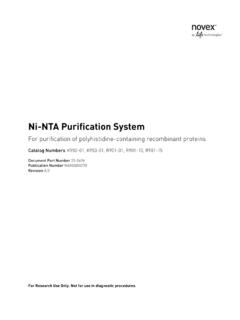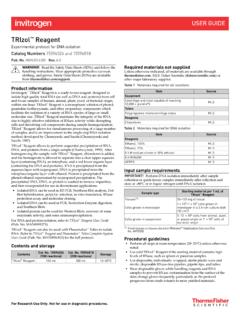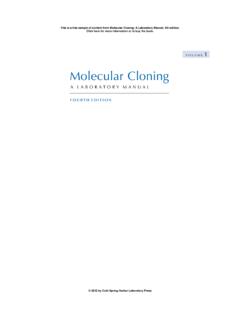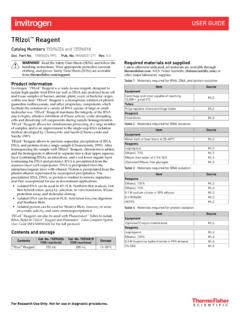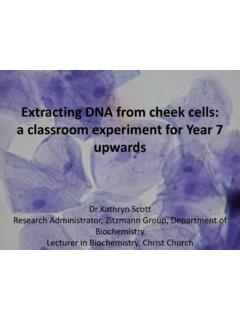Transcription of Recommended SDS PAGE Stain Protocols
1 Recommended SDS PAGE Stain Protocols Kits like GelCode Blue from Pierce and Biosafe Coomassie from Biorad are NOT compatible for in-gel digestion and mass spectrometry analysis unless you do a fixing step first. Please see below for a modified method for GelCode Blue. The gel must be fixed by a non-modifying, precipitation procedure such at the ethanol (or methanol)-acetic acid method used here. If the protein is not fixed in the gel as a separate step from the staining, the protein will be washed away and your results will be compromised.
2 This is especially important for low level digests. One may also note that handling of the gel should be minimized and that gloves should be worn at all times. These steps will minimize surface contamination of the gel. Standard Coomassie Stain In this staining protocol , all reagents are prepared immediately prior to use, including the Commassie blue Stain and destain solutions. It is our experience that using fresh reagents gives a darker, more consistent Stain with a lower background. In addition, the use of fresh reagents will minimize any contamination (keratin) of the gel.
3 At each stage of the procedure, the reagent is removed by vacuum aspiration. By aspirating the reagents off rather that pouring them off, gel-handling is minimized and contamination of and damage to the gel are avoided. One might note that the gel shrinks dramatically during the course of the fixing and staining and returns to its original size when equilibrated in the gel storage solution. The volumes noted are used for a single 20 cm x 20 cm gel and might be adjusted according the dimensions of the gel being stained. The procedure is carried out in ~25 cm x 40 cm glass dishes.
4 Stainless steel pans can be used, but plastic dishes should be avoided. All containers should be rinsed with ethanol or isopropyl alcohol first to minimize keratin. Gentle agitation of the dishes at all stages of the procedure will help ensure an even treatment if the gel. Reagents 1. Gel-fixing solution: Add 500mL of USP-grade 95% (v/v) ethanol to 300 mL of HPLC. grade water. Add 100 mL of reagent grade acetic acid and adjust the total volume to 1000 mL with water. The final concentrations are 50% (v/v) ethanol in water with 10%.
5 (v/v) acetic acid. 2. Gel-washing solution: Add 500mL of HPLC-grade methanol to 300 mL of HPLC grade water. Add 100mL of reagent grade acetic acid and adjust the total volume to 1000 mL. with HPLC grade water. The final concentrations are 50% (v/v) methanol in water with 10% (v/v) acetic acid. 3. Stain : Dissolve of Coomassie blue R350 in 200 mL of 40% (v/v) HPLC grade methanol in water with stirring as needed. Filter the solution to remove any insoluble material. Add 200mL of 20% (v/v) acetic acid in water. The final concentration is (w/v) Coomassie blue R350, 20% (v/v) methanol, and 10% (v/v) acetic acid.
6 4. Destain: Add 500mL of HPLC- grade methanol to 300 mL of HPLC grade water. Add 100 mL of reagent grade acetic acid and, after mixing, adjust the total volume to 1000mL with water. The final concentrations are 50% (v/v) methanol in water with 10%. (v/v) acetic acid. 5. Storage solution: Add 25mL of reagent grade acetic acid to 400mL of HPLC grade water. After mixing, adjust the final volume to 500mL with water. The final concentration of acetic acid is 5% (v/v). Procedure 1. After electrophoresis, the gel is washed off the glass plates with 500 mL of the gel-fixing solution and soaked in that solution for 1hr.
7 The purpose of this step is to gently remove the gel from the plate and begin washing the SDS-containing gel buffers out of the gel. At the end of this time, remove the solution by aspiration. 2. Cover the gel with 500mL of the gel-washing solution, and continue to fix the proteins in the gel by incubating overnight at room temperature with gentle agitation. The gel should be covered during this process to avoid contamination and to prevent the evaporation of the solution. At the end of this time, remove the solution by aspiration.
8 3. Cover the gel with 400mL of the Coomassie Stain . Stain the gel at room temperature for 3 to 4 hr with gentle agitation. The Coomassie Stain is removed by aspiration after staining. 4. Cover the gel with ~250mL of the destain solution and allow the gel to destain with gentle agitation. The destain solution should be changed several times, removing it at each change by aspiration. Continue the destaining until the protein bands are seen without background staining of the gel. 5. Equilibrate the gel in the 500mL of the storage solution for at least 1 hr.
9 The gel should return to its original dimensions during this process. 6. Store the gel in the storage solution as needed. It might be convenient to carefully transfer the gel to a heat-sealable bag for longer-term storage. Modified GelCode Blue Coomassie Stain Reagents 1. Gel-Code Blue Stain Reagent (PIERCE Cat. 24590 or 24592). 2. HPLC water or Mill-Q water. Procedure 1. Fix gel in fixing solution (50:10:40 / methanol: acetic acid: H2O) for 25 - 30 mins. 2. Wash the gel with 3 aliquots of water, shaking for 5 mins each. 3. Stain the gel in Gel-Code Blue Stain Reagent for 1 hour, gently rock at room temperature.
10 4. Wash the gel with ddH2O, shake about 2-3 hours, change water 3 to 4 times. 5. Store gel in 5% acetic acid solution at 4 C until in-gel digestion is performed (Gel can be stored for several weeks). Lava Purple or Deep Purple Reagents 1. Gel-fixing Solution: mix 850ml Double-distilled water, 150ml EtOH and 10g Citric Acid powder 2. Staining Solution: mix 1L Double-distilled water Boric Acid powder NaOH. and 5ml purple Stain concentrate 3. Washing Solution: mix 850ml Double-distilled water and 150ml EtOH. Procedure: 1. Fix gels in fix/acidification solution for 2 hours.



